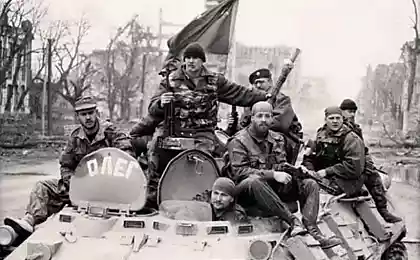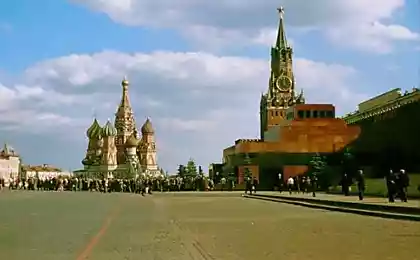803
Amateur photographers come from the USSR
Nostalgic ZhZhist germanych
_________________
One of people's hobbies was photography. My passion is to "plant" appears in the 5th grade a friend of the family - a photojournalist. He bought the first camera in my life. The camera is called "Change-8M" and was a sort of modern "boom box" (or rather, "Soap" recent past) - a very simple design, a standard lens irremovable. Cost "Change-8M" 15 rubles. It's not that expensive, but still thought it was not for children. Together with a camera family friend bought me two specific reagents for cell made of transparent colored plastic (orange developer and fixer for white) and black tank charging at the same time explaining how to use it. Then he drove off in another trip. And I proceeded to familiarization of this complex case.
5 ph + letter

Today, when the photos made by digital device, and if someone remained foil vestiges (such as my semi-Minolta), the services of photographers are items developing and printing Kodak, probably should say a few words about the patriarchal method of manufacturing the photos ( They say the way to come up with some of the closest descendants of November).
Before you start shooting, the film should be charged. No, not in the camera and in the cassette. What? The film has sold the cassette? Well, I do not. Soviet film sold packaged in black opaque paper. Cassettes had to buy separately. The roll was placed in the sample box indicating the sensitivity (32, 64, 130 and 250 units) and the manufacturer (or Tasma Svema). The most chassis was Svema-65, so (forgive me defenders light image), this film been in sales is not always. Most often it sold Tasma. But as lovers of photography in the Soviet Union was much less than fans of sausages, then such cases that the store did not have any film, I do not recall. But Svema-65 precisely the case with faults.
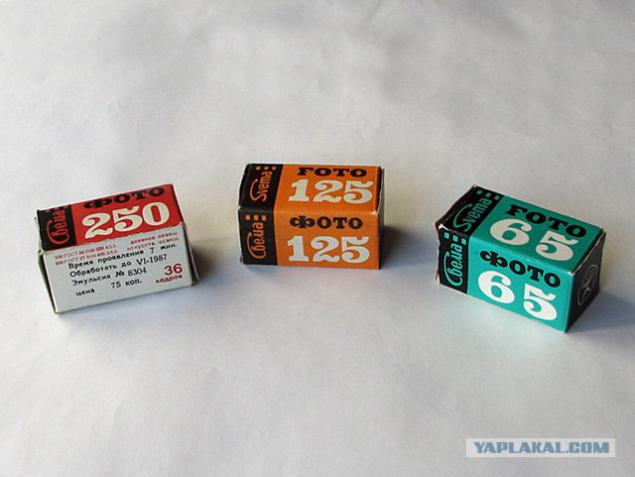
So, in complete darkness - in the bathroom or a wound on his hand blankets - it was necessary to remove the film from the package and a small wound on the reel to reel like a thread, then insert the bobbin into the cassette and close the lid. To learn this, first practiced on already manifested films captured the light. It was only after the film is loaded in the cassette, it can be inserted into the camera.

After the film finished shooting, it must be manifest. For what it is wound to the special coil and placed inside a light-tight tank (part of which is a spiral). Drum film, of course, it must also be in total darkness.
Then - already light - into the tank it is necessary to pour the developer. The developer should be prepared in advance. Other photo magicians did the developers of specialty chemicals, otmerivaya them on the scales. But the usual lowbrow amateurs like me buying a ready developer in Photoshop. By the way, the developer (and fixer as well), there are also intermittent. Therefore, for example, I personally gained just uphill bags developer and fixer, the benefit they cost - a penny.
The developer of the bags had different small crumbs, in this connection after the dissolution, it had to be filtered. For this purpose, every amateur photographer using what God will give. Personally, I filtered through a folded in several layers of cheesecloth. One portion of the developer enough for a few films.
The developer, fill the tank had to be a certain temperature - from 20 to 25 degrees. To monitor the temperature of every amateur photographer had a special thermometer (I have still lying around somewhere). Once the developer is poured into the tank, it is necessary to wait 8-10 minutes twisting spiral (via peering outward spiral tip). After that, the developer is poured into a special bank (to then use it for the next film). Then the tank is filled with water from the tap (also a certain temperature) for washing film. Then fill the fixer - reagent for fixing the emulsion film by exposure to light (why it is often called fixer).
The fixer film lay about 15-20 minutes, and then washed again and pulled the light of day - the most exciting time when you could tell, it came out or not. In addition, if the film was wound sticking, part of the film was not shown. But this usually happens only amatours. Then, the film had dried. I used to do this line, specifically for this purpose in the kitchen extended. After drying, the film is folded in a roll, which is placed in a box, in which the film is sold.
Since all the reagents can be used for developing several films, remained an open question just to show the film as photography or to save the desired number of films. The first option was fraught with the fact that it was necessary to keep the reactants in a liquid form, which also was not very long shelf life (less than one month). But, in general, it was the little things.
Yes, I forgot to say. Method, about which I have just said applies only to black-and-white film. For color film required very different reagents, consisting, if my memory serves me, four different liquids. In Moscow, on the whole it was easy to buy colored reagents from the GDR company «ORWO» - they were sold at specialty store "Jupiter" at the Kalinin Prospekt. But outside of Moscow with color reagents was not so chocolate. Simply put, they were deficient.
Themselves reagents for color printing, and color film cost more than black and white, and the process of developing and especially printing color film was much harder. Therefore, the lion's share of photographers prefer to do black-and-white photos. Some have been the use of so-called reversible film, ie, film for slides, which did not need to print photos, as soon as the developer could cut the film into frames, inserted in a special frame (sold in Photoshop) and show your friends using a special slide projectors. However, the automatic slide projectors are very expensive, so it is usually treated by manual, or simply used such plastic shtukentsii with an eye on the children's slides (also GDRovskih).
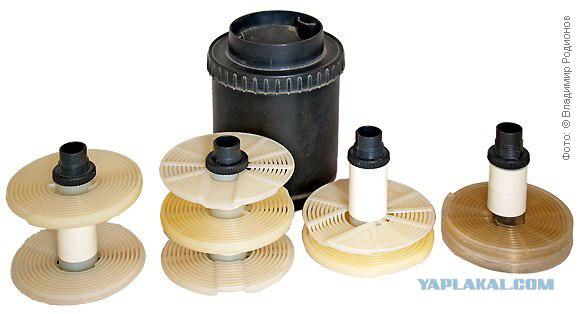
Wink film - a little. We still print photos from it. For these purposes requires a special Bandura called enlarger. Enlarger, simply, it is a light-proof container such as a cylinder or a sphere, which is installed inside the bulb. On one side of the cylinder - that which faces towards the floor - the lens is about the same as in the camera (albeit simpler). Between the lamp and the lens was packed into a groove film. Himself cylinder is fixed on a special bracket and can slide it up and down. The bracket is mounted in a special rectangular table top, closer to the edge.
The printing process is generally fairly straightforward. When the red light of a special lamp, non-illuminated sheet of paper is laid on the table enlarger, emulsion up. This usually every self-respecting amateur photographer had a special crop or resize. The cylinder lens on an arm raised to such a height that is required for a particular zoom - the higher, the greater the scale. Then for some number of seconds, the inner light, the image on photographic paper fell from the film and the exposure occurred. Further, the paper placed in the developer (as in the film), washed, and then in a fixer, washed again, and then was in a separate cell.
After all the boring pictures were printed, there comes an exciting time polishing. To do this it was necessary to have glyantsevatel - special electric contraption. The main details of gizmos were two flexible mirror paper. With special rubber roller, laid on a sheet of wet emulsion picture unrolls. Then the sheets with glued photographs firmly inserted into glyantsevatel, which was something like an electric fryer. Under the influence of high temperature dried pictures, and in addition we acquired characteristic luster - gloss. Here, actually, and all.
Needless to say, as the enlarger and glyantsevatel also sold every day. Of course they were not quite so horrible deficit, but still. For example, I took a long time magnifier at the box office (it was such a wonderful rental on Gogol Boulevard). And only a few years after the beginning of the career fotolyubitelskoy accidentally bought a normal enlarger in the "Jupiter."
The paper was varied. "Bromportret", "Fotobrom" something else - I do not remember the exact name. High-quality photo paper is not always the same. However, in the USSR everything it was not always high-quality.
Of course, the picture - this is a special world. It is, in fact, was like outside Sovdep. That is kumachovy Sovdep itself, as an amateur photographer - itself.
The main tool of the photographer - is, of course, a camera. I would not be surprised if I say that a good camera is not always sold. The most popular was a good reflex camera "Zenit-E" (talking about the late 70s - early 80s). It cost is not cheap, but still available - about 100 rubles. From time to time, "the Zenit-E" sold in "Jupiter" and to them immediately a queue. But usually, "the Zenit-E" were sold with some ugly lens (the name can not remember), and I wanted a lens "Helios". In general, in the end, his mother bought me to pull "Zenit-E" lens "Industar 61 LZ", which looked no worse "Helios».
On the other hand, almost any time you could buy a camera Zenit-TTL. But it was expensive - 240 rubles; and with special design (all black) - more expensive. In general, about ZENIT-TTL can only dream of. Also quite freely sold shirokoplёnochny mirror "Kiev". But it was also expensive. Foreign cameras on sale was not. Or rather, it was in a thrift shop on Sadovaya-Kudrinskaya. For the price of one thousand rubles and more. So that all there Pentaxa or Nikon could only lick looking at foreigners.
I remember the year because in 1981 occurred in Sokolniki International Exhibition "Film and Photo-body." As usual, the Muscovites and visitors at the weekend battle took this exhibition. I went on it a few times (which ran from school), pausing for a long time at the stands with foreign photography. On the stand Minolta's some compassionate Japanese mom gave us some pretty detailed color brochures Minolta cameras, which details the working principles, the drive image as the photographer sees through the viewfinder (this was something!). And they themselves colored, printed with unprecedented quality for the USSR on coated paper pamphlets, and those cameras that I saw there made a lasting impression on me. For life. I'm from the moment dreamed of Minolt'e. Of course I understand that I will never be her. But I am dreaming. A childhood dream was realized in 2003 alone. I do not know what bought a semi-professional film cameras Minolta. In principle, just money thrown, because everything is already switched to digital. But childhood dream - it is such a dream, for which money is not sorry.
It follows from all the above, it was not cheap fotolyubitelstvo fun. And in terms of money and time-consuming (film development, printing) - it was troublesome. Therefore such indiscriminate possession of cameras in the population was not. For example, we have cameras in the class (the. Private) had 4-5 people.
Pictures, however, are usually typical things: joint gatherings, trips, etc. Some genre pictures from amateur photographers was not enough. Yes, it is understandable - because the last big camera with every day is not diarrhea. Not today - I saw a burning house, took out his cell phone and - schёlk. No, in those days it was necessary to Photo sketch specially assembled.
We are here with a school friend in high school, sick passion to photograph the church. I do not know where we, members of the Komsomol, the desire is awakened. But we climbed all over Moscow, looking for the church. And then they in fact sometimes it was necessary to look for (for most of the churches were warehouses or offices). But here's what I'm terribly sorry - Church-we took pictures, but just to photograph the streets of Moscow, the ordinary people, we somehow did not occur. That there is so much to us it seemed uninteresting and immutable, that tell us that in 20 years, none of this would be - in life believed. However, a photo is not relevant.
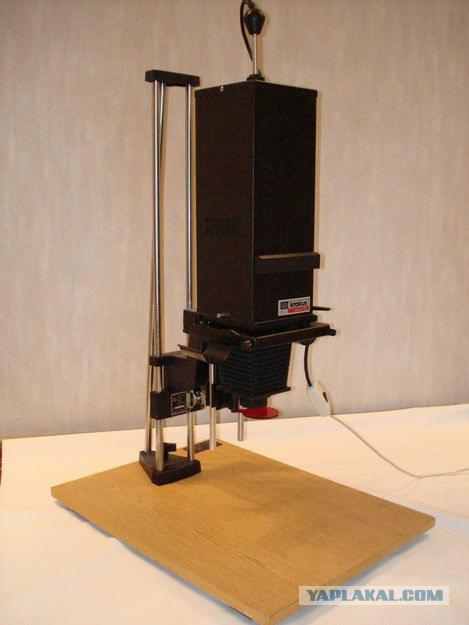
Source:
_________________
One of people's hobbies was photography. My passion is to "plant" appears in the 5th grade a friend of the family - a photojournalist. He bought the first camera in my life. The camera is called "Change-8M" and was a sort of modern "boom box" (or rather, "Soap" recent past) - a very simple design, a standard lens irremovable. Cost "Change-8M" 15 rubles. It's not that expensive, but still thought it was not for children. Together with a camera family friend bought me two specific reagents for cell made of transparent colored plastic (orange developer and fixer for white) and black tank charging at the same time explaining how to use it. Then he drove off in another trip. And I proceeded to familiarization of this complex case.
5 ph + letter

Today, when the photos made by digital device, and if someone remained foil vestiges (such as my semi-Minolta), the services of photographers are items developing and printing Kodak, probably should say a few words about the patriarchal method of manufacturing the photos ( They say the way to come up with some of the closest descendants of November).
Before you start shooting, the film should be charged. No, not in the camera and in the cassette. What? The film has sold the cassette? Well, I do not. Soviet film sold packaged in black opaque paper. Cassettes had to buy separately. The roll was placed in the sample box indicating the sensitivity (32, 64, 130 and 250 units) and the manufacturer (or Tasma Svema). The most chassis was Svema-65, so (forgive me defenders light image), this film been in sales is not always. Most often it sold Tasma. But as lovers of photography in the Soviet Union was much less than fans of sausages, then such cases that the store did not have any film, I do not recall. But Svema-65 precisely the case with faults.

So, in complete darkness - in the bathroom or a wound on his hand blankets - it was necessary to remove the film from the package and a small wound on the reel to reel like a thread, then insert the bobbin into the cassette and close the lid. To learn this, first practiced on already manifested films captured the light. It was only after the film is loaded in the cassette, it can be inserted into the camera.

After the film finished shooting, it must be manifest. For what it is wound to the special coil and placed inside a light-tight tank (part of which is a spiral). Drum film, of course, it must also be in total darkness.
Then - already light - into the tank it is necessary to pour the developer. The developer should be prepared in advance. Other photo magicians did the developers of specialty chemicals, otmerivaya them on the scales. But the usual lowbrow amateurs like me buying a ready developer in Photoshop. By the way, the developer (and fixer as well), there are also intermittent. Therefore, for example, I personally gained just uphill bags developer and fixer, the benefit they cost - a penny.
The developer of the bags had different small crumbs, in this connection after the dissolution, it had to be filtered. For this purpose, every amateur photographer using what God will give. Personally, I filtered through a folded in several layers of cheesecloth. One portion of the developer enough for a few films.
The developer, fill the tank had to be a certain temperature - from 20 to 25 degrees. To monitor the temperature of every amateur photographer had a special thermometer (I have still lying around somewhere). Once the developer is poured into the tank, it is necessary to wait 8-10 minutes twisting spiral (via peering outward spiral tip). After that, the developer is poured into a special bank (to then use it for the next film). Then the tank is filled with water from the tap (also a certain temperature) for washing film. Then fill the fixer - reagent for fixing the emulsion film by exposure to light (why it is often called fixer).
The fixer film lay about 15-20 minutes, and then washed again and pulled the light of day - the most exciting time when you could tell, it came out or not. In addition, if the film was wound sticking, part of the film was not shown. But this usually happens only amatours. Then, the film had dried. I used to do this line, specifically for this purpose in the kitchen extended. After drying, the film is folded in a roll, which is placed in a box, in which the film is sold.
Since all the reagents can be used for developing several films, remained an open question just to show the film as photography or to save the desired number of films. The first option was fraught with the fact that it was necessary to keep the reactants in a liquid form, which also was not very long shelf life (less than one month). But, in general, it was the little things.
Yes, I forgot to say. Method, about which I have just said applies only to black-and-white film. For color film required very different reagents, consisting, if my memory serves me, four different liquids. In Moscow, on the whole it was easy to buy colored reagents from the GDR company «ORWO» - they were sold at specialty store "Jupiter" at the Kalinin Prospekt. But outside of Moscow with color reagents was not so chocolate. Simply put, they were deficient.
Themselves reagents for color printing, and color film cost more than black and white, and the process of developing and especially printing color film was much harder. Therefore, the lion's share of photographers prefer to do black-and-white photos. Some have been the use of so-called reversible film, ie, film for slides, which did not need to print photos, as soon as the developer could cut the film into frames, inserted in a special frame (sold in Photoshop) and show your friends using a special slide projectors. However, the automatic slide projectors are very expensive, so it is usually treated by manual, or simply used such plastic shtukentsii with an eye on the children's slides (also GDRovskih).

Wink film - a little. We still print photos from it. For these purposes requires a special Bandura called enlarger. Enlarger, simply, it is a light-proof container such as a cylinder or a sphere, which is installed inside the bulb. On one side of the cylinder - that which faces towards the floor - the lens is about the same as in the camera (albeit simpler). Between the lamp and the lens was packed into a groove film. Himself cylinder is fixed on a special bracket and can slide it up and down. The bracket is mounted in a special rectangular table top, closer to the edge.
The printing process is generally fairly straightforward. When the red light of a special lamp, non-illuminated sheet of paper is laid on the table enlarger, emulsion up. This usually every self-respecting amateur photographer had a special crop or resize. The cylinder lens on an arm raised to such a height that is required for a particular zoom - the higher, the greater the scale. Then for some number of seconds, the inner light, the image on photographic paper fell from the film and the exposure occurred. Further, the paper placed in the developer (as in the film), washed, and then in a fixer, washed again, and then was in a separate cell.
After all the boring pictures were printed, there comes an exciting time polishing. To do this it was necessary to have glyantsevatel - special electric contraption. The main details of gizmos were two flexible mirror paper. With special rubber roller, laid on a sheet of wet emulsion picture unrolls. Then the sheets with glued photographs firmly inserted into glyantsevatel, which was something like an electric fryer. Under the influence of high temperature dried pictures, and in addition we acquired characteristic luster - gloss. Here, actually, and all.
Needless to say, as the enlarger and glyantsevatel also sold every day. Of course they were not quite so horrible deficit, but still. For example, I took a long time magnifier at the box office (it was such a wonderful rental on Gogol Boulevard). And only a few years after the beginning of the career fotolyubitelskoy accidentally bought a normal enlarger in the "Jupiter."
The paper was varied. "Bromportret", "Fotobrom" something else - I do not remember the exact name. High-quality photo paper is not always the same. However, in the USSR everything it was not always high-quality.
Of course, the picture - this is a special world. It is, in fact, was like outside Sovdep. That is kumachovy Sovdep itself, as an amateur photographer - itself.
The main tool of the photographer - is, of course, a camera. I would not be surprised if I say that a good camera is not always sold. The most popular was a good reflex camera "Zenit-E" (talking about the late 70s - early 80s). It cost is not cheap, but still available - about 100 rubles. From time to time, "the Zenit-E" sold in "Jupiter" and to them immediately a queue. But usually, "the Zenit-E" were sold with some ugly lens (the name can not remember), and I wanted a lens "Helios". In general, in the end, his mother bought me to pull "Zenit-E" lens "Industar 61 LZ", which looked no worse "Helios».
On the other hand, almost any time you could buy a camera Zenit-TTL. But it was expensive - 240 rubles; and with special design (all black) - more expensive. In general, about ZENIT-TTL can only dream of. Also quite freely sold shirokoplёnochny mirror "Kiev". But it was also expensive. Foreign cameras on sale was not. Or rather, it was in a thrift shop on Sadovaya-Kudrinskaya. For the price of one thousand rubles and more. So that all there Pentaxa or Nikon could only lick looking at foreigners.
I remember the year because in 1981 occurred in Sokolniki International Exhibition "Film and Photo-body." As usual, the Muscovites and visitors at the weekend battle took this exhibition. I went on it a few times (which ran from school), pausing for a long time at the stands with foreign photography. On the stand Minolta's some compassionate Japanese mom gave us some pretty detailed color brochures Minolta cameras, which details the working principles, the drive image as the photographer sees through the viewfinder (this was something!). And they themselves colored, printed with unprecedented quality for the USSR on coated paper pamphlets, and those cameras that I saw there made a lasting impression on me. For life. I'm from the moment dreamed of Minolt'e. Of course I understand that I will never be her. But I am dreaming. A childhood dream was realized in 2003 alone. I do not know what bought a semi-professional film cameras Minolta. In principle, just money thrown, because everything is already switched to digital. But childhood dream - it is such a dream, for which money is not sorry.
It follows from all the above, it was not cheap fotolyubitelstvo fun. And in terms of money and time-consuming (film development, printing) - it was troublesome. Therefore such indiscriminate possession of cameras in the population was not. For example, we have cameras in the class (the. Private) had 4-5 people.
Pictures, however, are usually typical things: joint gatherings, trips, etc. Some genre pictures from amateur photographers was not enough. Yes, it is understandable - because the last big camera with every day is not diarrhea. Not today - I saw a burning house, took out his cell phone and - schёlk. No, in those days it was necessary to Photo sketch specially assembled.
We are here with a school friend in high school, sick passion to photograph the church. I do not know where we, members of the Komsomol, the desire is awakened. But we climbed all over Moscow, looking for the church. And then they in fact sometimes it was necessary to look for (for most of the churches were warehouses or offices). But here's what I'm terribly sorry - Church-we took pictures, but just to photograph the streets of Moscow, the ordinary people, we somehow did not occur. That there is so much to us it seemed uninteresting and immutable, that tell us that in 20 years, none of this would be - in life believed. However, a photo is not relevant.

Source:













